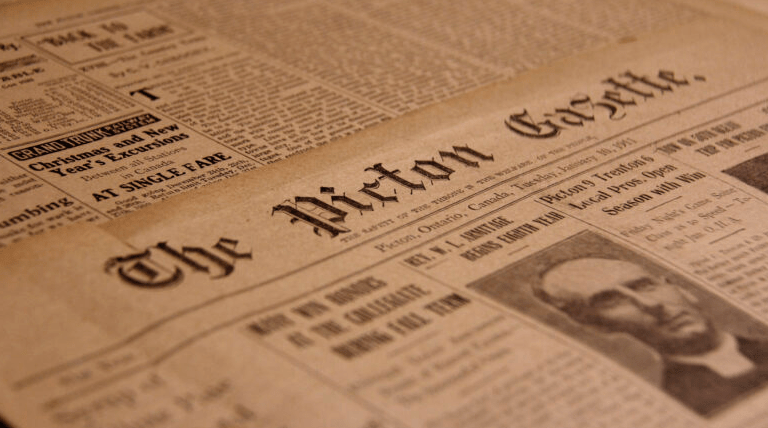 Living History
Living History
PHOTOGRAPHIC Terms of common occurrence, and Maxims, popularly explained, BY J. A. S.
EDITOR’S NOTE: This is an Advertisement published in the Picton Gazette, 30 October, 1863, and at other times this year. Practical photography had begun with the Daguerreotype in the late 1830s, and become more affordable and reproducible by the 1850s. Two Picton photographers regularly advertised in the Gazette at this time: J. A. Sherriff and D. Dingman. Their advertisements from this issue are reproduced below.
(The following article is not intended to be a piece of information for the profession; but as a medium of instruction between Photographer and customer. By having this article, or printed copies of it, lying open in their galleries, or having it re-published in local papers, Photographers will insure a great benefit, by saving an immense amount of labour, time and expense, now “running to waste” by the existing ignorance and arrogance of a certain portion of their customers.)
Photograph—A picture on paper.
Daguerreotype—A picture on silver plate; at present generally out of use for being too expensive.

A photograph of Charles Fredrick Allison taken by D. Dingman in Picton in the 1870’s.
Ambrotype—A picture on glass.
Melainotype or Ferrotype—A picture on japanned iron.
Negative—The glass plate upon which every picture for a photograph is taken. The image is not clearly nor favourably seen (and therefore should properly not be asked to be shown,) but is so fixed on the plate as to allow of making an unlimited number of photographs, of uniform quality; Unless the plate gets spoiled by a chemical or mechanical accident.
Proof—The first photograph made from a negative. Generally executed without care or finish, as it is mainly intended to give, without incurring much expense for the photographer, to the person and idea of the general appearance of the picture. Like the printer’s proof sheet, it is usually full of defects, which of course will disappear in the final photograph.
Tone–The colour of the photographic image; it is either reddish, or black, rosy purple or neutral; the last tones being considered the most artistic and valuable.
Shade—The various degrees between light and dark. Except when a picture is too light or too dark; a mirror slight difference in a number of pictures is no matter for objection, still less when we consider that, in ten persons, five will prefer a light copy and five a dark one period no part of a photograph can be made lighter or darker without equally increasing all other parts.
Colours, as represented in the photograph—White, blue, pink, lilac, will always take light;–black, brown, yellow, scarlet, and green, always dark. This is the natural force of the actinic rays of light which no photographer can alter. It is for this reason that blue eyes usually take very light, and a yellowish complexion dark.
Position, posture, pose,—Is the appearance of the head and body in a picture. It should be natural, easy, and characteristic of the person. Anything like assumed will not do: the picture betrays the effort and belies the subject. (We cannot make a Hesperide of every apple-woman, and a Ulysses of every auctioneer!) But the Artist may judiciously suggest one or more favourable modification of the position, always keeping with the character of the sitter. When people prefer choosing their own position, or follow the advice of friends which they may bring with them, in whom they place more confidence than in the Artist, the latter is certainly not responsible for the appearance of the picture in this respect; but, should insist on being promptly paid for his labor, whether the Photograph is accepted or not.
Expression in the face.—Persons should remember this is a thing of their own, almost entirely beyond the control of the Photographer. If you look tired, tedious or disdainful during sitting for your picture, the picture will look the same, and the Photographer is not to blame; nor does it seem fair in the least to refuse an otherwise good picture on that account. Persons who naturally look sad, or sour, or scowling, should not unreasonably expect to look otherwise in a photograph.
Picton, C. W.
[Classified advertisements for photographers in the same issue.]
J.A. Sgherriff’s
DAGUERREAN GALLERY.
LIKENESSES taken in a style superior to any other in Canada. Operating hours from 9 a. m. till 4 p. m. “Union Buildings,” Main-st. Picton, UP STAIRS.
P.S.—Instructions given in the art.
D. DINGMAN’S
PHOTOGRAPHIC GALLERY.
LIKENESSES taken in a style superior to any other Gallery in the County.
Operating hours from 8 A. M., till 6 P. M. in Messrs. Chapman & Striker’s new building,
Main Street, Picton, UP STAIRS.
P. S. Instruction given in the Art.
Picton, June 20, 1861.
[A personal classified ad from 28 Mar 1862 perhaps brings some context.]
The Subscriber tenders his sincere thanks to his FRIEND for the great trouble he took to mutilate his Card, and trusts for the future he will not expose himself to the injurious effects of night air; but step up like a man and gratify his animosity in the day time.
D. DINGMAN,
Photographic Artist,
Picton, C. W.
See it in the newspaper